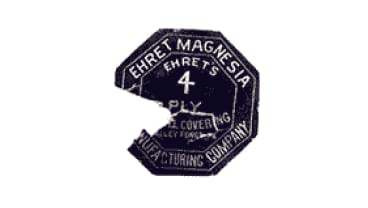Ehret Magnesia
From 1924 to 1972, Ehret Magnesia manufactured asbestos-containing insulation products. The company faced asbestos lawsuits that forced it into bankruptcy. A trust fund was created with $45 million to handle future asbestos claims.

Ehret Magnesia’s History with Asbestos
Founded in 1897, the Ehret Magnesia Manufacturing Company achieved commercial success with Thermalite and Durocel, signature brands of asbestos pipe insulation.
The company purchased several limestone mining operations located in Valley Forge, Pennsylvania, just outside of Philadelphia, and operated an asbestos manufacturing plant there from the 1890s to the 1970s.
Combining imported raw asbestos with materials excavated from its limestone quarry, Ehret produced and distributed an expansive line of thermal insulation products and construction supplies.
Ehret employees and the end users of Ehret products were exposed to asbestos and later developed mesothelioma and other life-threatening respiratory illnesses.
Ehret began running monthly product advertisements in an asbestos industry trade magazine in 1930. That year, the magazine ran an article about asbestosis. By the late 1950s, Ehret Magnesia chemist John D. McAllister acknowledged the company’s substantial concern over three Ehret employees who died of lung cancer and benign lung conditions.
Even with knowledge of the mineral’s health effects, Ehret continued to manufacture asbestos products. In 1959, the company merged with insulation manufacturer Baldwin-Hill to form Baldwin-Ehret-Hill. The new company operated until 1968, the year it was acquired by Keene Corporation. While Keene did not manufacture any asbestos products, it continued to sell them.
In an attempt to expand into the fireproofing business, Keene acquired several more companies over the next few years. But by the early 1970s, operations at the manufacturing plant ceased. In 1976, the U.S. government purchased the Keene manufacturing plant in Pennsylvania and 46 acres of property to be used by the National Park Service.
As the successor in interest to Ehret Magnesia and Baldwin-Ehret-Hill, Keene inherited liability for the harm caused by their products.
In 1981, Keene’s president created Bairnco Corporation, a holding company for the numerous businesses he had acquired. Keene disposed of 2,425 asbestos cases by the end of that year, but Bairnco still faced nearly 9,000 outstanding lawsuits. In 1990, Bairnco parted with the Keene Corporation at a cost of $6 million, but the claims did not cease.
Development of the Keene Creditors Trust
Feeling the pressure of more than 100,000 related claims, Keene filed for bankruptcy on Dec. 3, 1993.
After emerging from bankruptcy on June 13, 1996, the company created the Keene Creditors Trust, a trust fund established with $45 million to handle future asbestos claims.
The trust remains active and its current payment percentage is 0.8%.

Gain access to trust funds, grants and other forms of compensation for you or your loved ones.
Get Help NowAsbestos Litigation Involving Keene Corporation
Keene Corporation began defending personal injury lawsuits as early as 1971. Even though the company purged asbestos-containing materials from its product line the following year, workers exposed decades prior came forward demanding compensation for their related illnesses.
- One notable lawsuit involved Henry Tragarz, a former sheet metal worker who was exposed to Baldwin-Ehret-Hill’s Thermasil asbestos block at various job sites throughout the 1960s and ’70s. While Tragarz rarely handled the mineral himself, he regularly worked alongside insulators and pipefitters whose activities stirred up thick clouds of asbestos dust. The jury returned a $3 million verdict in favor of the plaintiff, holding Keene Corporation and Owens-Corning Fiberglas Company liable for Tragarz’s death from pleural mesothelioma.
- In another lawsuit filed against the Keene Corporation, George Coffman asserted that Keene and eight other defendants were responsible for his substantial lung scarring and asbestosis. Working as an electrician at the Philadelphia Naval Shipyard from 1951 to 1969, Coffman experienced ongoing exposure while servicing and overhauling various ships and submarines. The jury decided that seven of the defendants, including Keene, substantially contributed to Coffman’s illness. Coffman was awarded $406,000, which included damages for pain and suffering, emotional distress and future medical surveillance.
Ehret Magnesia’s Asbestos Products
Asbestos-containing products manufactured or distributed by Ehret Magnesia, Baldwin-Ehret-Hill and Keene Corporation include:
- B-H insulating cement
- B-H #1 insulating cement
- Durocel pipe insulation
- Enduro block insulation
- Enduro insulating cement
- Enduro pipe covering
- Monoblock insulating block
- Mono-Spray fireproofing
- No. 1 insulating cement
- No. 1 Plus insulating cement
- Pyrospray fireproofing
- Pyrospray “S” fireproofing
- Styltone
- Super Powerhouse insulating cement
- Thermalite block insulation
- Thermalite insulating cement
- Thermalite pipe covering
- Thermasil block insulation
- Thermasil pipe covering
- Uni-Coustic
- Ehret asbestos sponge felt
- Ehret Air Cell
- Ehret Fibrekote
- Ehret asbestos paper
- Ehret asbestos corrugated paper
- Ehret asbestos millboard
- Ehret asbestos wick and rope
- Baldwin Mono-Block asbestos covering
- Valley Forge asbestos sheets, packings and gaskets
Ehret Magnesia added amphibole asbestos fibers to its popular Thermolite brand pipe insulation. Although it made for excellent insulation, insulators and pipefitters who installed, repaired and removed Thermolite faced ongoing exposure hazards.
The insulation was removed prior to pipe repairs, and replacing old pipes required cutting that released toxic fibers into the air.
Ehret Magnesia’s Occupations at Risk
The following occupations faced risk of exposure to Ehret Magnesia’s asbestos products:
- Ehret Magnesia manufacturing plant workers
- Veterans of the U.S. Navy and Coast Guard
- Shipyard workers
- Pipefitters
- Shipfitters
- Insulators
- Boiler workers
- Construction workers
- Plumbers
- Electricians
- Carpenters
- Chemical plant workers
- Metal workers
- Industrial workers
- Factory workers
- Power plant workers
Products manufactured by Ehret Magnesia, Baldwin-Ehret-Hill and Keene Corporation put thousands of workers at risk. These companies produced many asbestos-tainted products that affected several industries, most frequently harming workers in construction and shipbuilding.
Most at risk, however, were Ehret Magnesia and Keene Corporation employees who worked at the plant in the Valley Forge National Historical Park from the early 1890s to the 1970s. These workers regularly handled raw asbestos and may have been exposed to waste that was illegally disposed of for decades.
A 2022 report by the European Commission noted that in 2019 alone, over 70,000 workers died from past exposure to asbestos.
Exposure to Thermolite and other Ehret Magnesia insulation products occurred in shipyards, typically during the construction and repair of U.S. Navy and U.S. Coast Guard vessels. Often working in tight quarters with inadequate ventilation, pipefitters, insulators and boiler workers commonly released clouds of toxic dust that threatened the health of all workers in the vicinity.
A January 2019 study published in the International Journal of Radiation Biology shows these military professions were among the jobs with the highest potential for asbestos exposure. This group accounts for a large excess of mesothelioma deaths among veterans.
Construction workers also suffered exposure from Ehret products such as asbestos insulation cement and asbestos millboard. Electricians, carpenters and other laborers worked around these products and faced risks of asbestos exposure.
Illegal Dumping by Ehret Magnesia Exposed Pennsylvania Residents
In January 1997, workers discovered asbestos-contaminated soil while running fiber optic cable near the former site of Ehret Magnesia’s asbestos plant near Philadelphia. It later came to light that Ehret had illegally dumped waste into abandoned quarries and the Schuylkill River for decades. Further, the company did so with permission from the Pennsylvania state government.
Within several months, the U.S. Environmental Protection Agency determined an emergency removal action was necessary. With an initial investment of $200,000, the agency fenced off the contaminated area, covered the dangerous materials with soil, wet exposed asbestos to reduce airborne fibers and conducted ongoing sampling of the soil and air.
While the agency deemed the emergency removal action complete by July 1997, future projects are expected.
Recommended Reading


